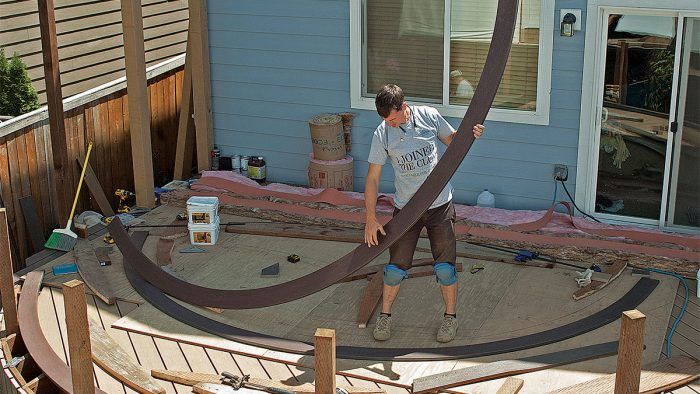Multi-Feature Curved Deck: Bending a PVC Plank
Build a form, apply heat, and bend the radiused edge planks for a stylish custom look.

As a finishing touch on this deck, deck designer Kim Katwijk opted to edge the decking with a double band of bent planks in a contrasting color. On the upper level, the planks are bent to a radius of 9 ft. 8 in. and 9 ft. 2 in. The lower level called for a radius of 7 ft. 6 in. and 7 ft.
Once a piece of PVC decking is heated to about 210°F (composite decking takes up to 265°F because of its wood content), it briefly becomes as limp as a wet noodle. Clamped into forms, it can easily be bent into sweeping curves. Once cooled, the piece holds its new shape, rigid as ever. Simple as the process sounds, it takes planning—as well as some commercial-grade blanket heaters, fiberglass insulation batts, an accurate form with plenty of clamps, and a crew of nimble workers who know what they are doing.
Making the FormThere is a smidge of give in the bent planks, but the more accurate the form, the better. Because of the intense heat of the planks, they cannot be laid on the decking itself—a lesson some deck builders have learned the hard way when the surface of their deck blistered under the plank. Instead, lay down plywood and attach it to the joists by running fasteners into the gap between planks. Mark and cut scrap 2x8s to make a radius to which the heated decking can be clamped. This deck calls for two pieces of edging. The second piece can be clamped to the first without allowing for the gap; there is enough give in the plank to add spacers while fastening. |
1. Prepare the “oven.” With insulation rolled out the full length of the decking, lay down the heat blankets. Position the decking and bore a 4-in.-deep, 1/8-in. hole for the thermostat probe.

3. Add the top blankets. Lay the top blanket in place. The heating filaments stop about 1/2 in. short of the end of each blanket. Overlap them to avoid a cool area in the plank.
4. Stagger the blankets. To avoid overheating the edges, stagger the blankets slightly. Smooth them out so they are in complete contact with the decking.
5. Add the insulation. Complete the oven by laying a second roll of insulation on top of the plank and the heat blankets.
8. Form up the decking. With one piece of decking already bent, wrap the second piece around it and clamp the ends.
9. Add blocks. Fasten scraps of decking to hold the piece without denting. Double-check for any creases or bulges. Rub them out with a scrap of decking aided by careful use of a heat gun, if necessary.
10. Let it cool. After about 10 minutes, the piece should be cool and as stiff as it was in its original form.
11. Complete the bends. By adapting the radius pieces already cut, you can make forms for the other edge pieces.
Fine Homebuilding Recommended Products
Fine Homebuilding receives a commission for items purchased through links on this site, including Amazon Associates and other affiliate advertising programs.

Jigsaw

MicroFoam Nitrile Coated Work Gloves

FastenMaster Screw Bolt Fastening System















